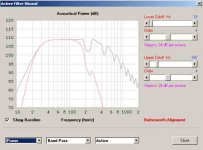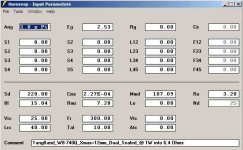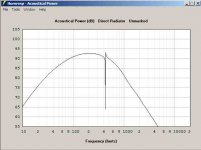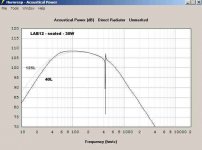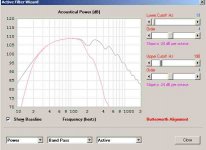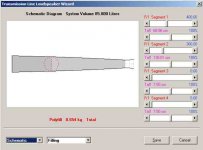Karlson K15 do work very well (don't discount them) but they can be large and don't do the 20 - 40 Hz very well unless EQ'd
+1
The ideal would be a K15 with a TH sub to cover the last two octaves. Well IMHO anyway.
Good to know about the basshorn dip, CLS.
DeonC, the new horns + a K15 + a TH is more enclosures than my room would allow.
tb46, yes, I am intrigued by your transmission line. I'd love to see the plans, although I'm not sure the box aspect would be the best for my space. I actually spent WAY more time on the internet yesterday than anyone should, reading into your suggestion from post #10 on PPSL. They are very interesting. Four 12" still seem a bit of an overkill for the space, but maybe I'm wrong. Has anybody every done this successfully with 10"s or even 8"s?
That lead me to also look into w-frames, ripoles, and other dipoles.
Does anyone have any thoughts on these? Rereading this thread, I see Inductor previously suggested a couple of 12"s in a W configuration. Ripoles seem very nice as well. Yes, I realize the sensitivity (or lack thereof) would probably dictate that I build a new amp.
I came across a drawing tb46 posted of an 8" sealed push-pull box using the TangBand W8/740Q. Did you ever measure or simulate the frequency response of this?
Sorry about the tons of questions! Thanks always for any advice and helpful information.
Last question, and only one posed out of curiosity. No need to answer if nobody feels like it! Does anyone every use discrete numerical simulation to model actual wave behaviour in enclosures? I suspect it wouldn't be absurdly difficult to develop some finite element or spectral element modelling to deal with this rather than using empirical relationships.
Thanks again.
DeonC, the new horns + a K15 + a TH is more enclosures than my room would allow.
tb46, yes, I am intrigued by your transmission line. I'd love to see the plans, although I'm not sure the box aspect would be the best for my space. I actually spent WAY more time on the internet yesterday than anyone should, reading into your suggestion from post #10 on PPSL. They are very interesting. Four 12" still seem a bit of an overkill for the space, but maybe I'm wrong. Has anybody every done this successfully with 10"s or even 8"s?
That lead me to also look into w-frames, ripoles, and other dipoles.
Does anyone have any thoughts on these? Rereading this thread, I see Inductor previously suggested a couple of 12"s in a W configuration. Ripoles seem very nice as well. Yes, I realize the sensitivity (or lack thereof) would probably dictate that I build a new amp.
I came across a drawing tb46 posted of an 8" sealed push-pull box using the TangBand W8/740Q. Did you ever measure or simulate the frequency response of this?
Sorry about the tons of questions! Thanks always for any advice and helpful information.
Last question, and only one posed out of curiosity. No need to answer if nobody feels like it! Does anyone every use discrete numerical simulation to model actual wave behaviour in enclosures? I suspect it wouldn't be absurdly difficult to develop some finite element or spectral element modelling to deal with this rather than using empirical relationships.
Thanks again.
I only skimmed through this post, so if I missed something, sorry.
You said tri-amped.
If this is an active system, my next comment is useless.
IF you use a passive crossover for the base, you must use an iron cored, low Rdc inductor. I like the Mundorf's. Air core for the woofer limits deep base.
If you use an active system, does it allow shelving of the base? If not, consider a DPS with this feature.
You said tri-amped.
If this is an active system, my next comment is useless.
IF you use a passive crossover for the base, you must use an iron cored, low Rdc inductor. I like the Mundorf's. Air core for the woofer limits deep base.
If you use an active system, does it allow shelving of the base? If not, consider a DPS with this feature.
Billy, my knowledge is very limited. What do you mean by 'shelving the bass'?
The system has 3 amps: 1 driving the compression tweeters (horn inside main drivers), 1 driving the tractrix mids, and 1 driving the woofers/subs. I've used the output caps of the 2 tube amps as high-pass filters for the dual concentrics. I very much like the way this sounds. I was thinking of simply using a line-level crossover between one pair of outputs from my preamp and the solid-state sub amp as an interim solution and then maybe making Pete Millett's active crossover or a marchand active crossover in the future.
The system has 3 amps: 1 driving the compression tweeters (horn inside main drivers), 1 driving the tractrix mids, and 1 driving the woofers/subs. I've used the output caps of the 2 tube amps as high-pass filters for the dual concentrics. I very much like the way this sounds. I was thinking of simply using a line-level crossover between one pair of outputs from my preamp and the solid-state sub amp as an interim solution and then maybe making Pete Millett's active crossover or a marchand active crossover in the future.
Post #23/24
Hi astrojet,
I do know what you mean when you say: "...spent WAY more time on the internet yesterday than anyone should..."
I'll attach the current drawing of the LAB12 transmission line (MOD4). For reference take a look here:
http://www.diyaudio.com/forums/subw...ded-transmission-line-od-ml-tl-design-bj.html
It started w/ bjorno's suggestion of a OD_ML-TL which went through all kinds of different versions/folds/builds, and ended up w/ my suggestion for a tapered transmission line (TTL). NWCgrad compiled my drawings w/ his cutsheets in Posts #270/273, and thejessman presented his build in Post #308. This enclosure (MOD3) is about as small as I can get it, and still get close to 20Hz. Thejessman is using it w/ a JBL GTO1214 and a Dayton 250W plate amp, and is not "wanting for any more output". For the MOD4 version my goal is to get room for a plate amp, and to reduce the outside dimensions to improve the wood usage. In the drawing the driver baffle is build up from 3/4-1/4-1/4-3/4"nom. plywood, that could be improved upon, there should be some additional braces (as in MOD3). If you like a different box aspect, there are a number of examples in the above thread. Anyway, this drawing might be sufficient to get started on building it.
The dual 8" sealed push-pull box w/ the Tang BAnd W8-740Q will need some help @ the low end, and that means a bigger amplifer to deliver the power necessary for e.g.: the Linkwitz transform. The power rating for ea. driver is 150/300W (whatever that means ).
).
ESP - The Linkwitz Transform Circuit
It should be fine to build PPSL style enclosures w/ any size driver. The smaller enclosures will end up w/ smaller plenums, and can be used to higher frequencies. Because of the distortion cancelling interaction of the drivers inexpensive drivers should work well in this arrangement.
Regards,
Hi astrojet,
I do know what you mean when you say: "...spent WAY more time on the internet yesterday than anyone should..."
I'll attach the current drawing of the LAB12 transmission line (MOD4). For reference take a look here:
http://www.diyaudio.com/forums/subw...ded-transmission-line-od-ml-tl-design-bj.html
It started w/ bjorno's suggestion of a OD_ML-TL which went through all kinds of different versions/folds/builds, and ended up w/ my suggestion for a tapered transmission line (TTL). NWCgrad compiled my drawings w/ his cutsheets in Posts #270/273, and thejessman presented his build in Post #308. This enclosure (MOD3) is about as small as I can get it, and still get close to 20Hz. Thejessman is using it w/ a JBL GTO1214 and a Dayton 250W plate amp, and is not "wanting for any more output". For the MOD4 version my goal is to get room for a plate amp, and to reduce the outside dimensions to improve the wood usage. In the drawing the driver baffle is build up from 3/4-1/4-1/4-3/4"nom. plywood, that could be improved upon, there should be some additional braces (as in MOD3). If you like a different box aspect, there are a number of examples in the above thread. Anyway, this drawing might be sufficient to get started on building it.
The dual 8" sealed push-pull box w/ the Tang BAnd W8-740Q will need some help @ the low end, and that means a bigger amplifer to deliver the power necessary for e.g.: the Linkwitz transform. The power rating for ea. driver is 150/300W (whatever that means
ESP - The Linkwitz Transform Circuit
It should be fine to build PPSL style enclosures w/ any size driver. The smaller enclosures will end up w/ smaller plenums, and can be used to higher frequencies. Because of the distortion cancelling interaction of the drivers inexpensive drivers should work well in this arrangement.
Regards,
Attachments
astrojet, go to www.alldsp.com . They have a module (many models). This module takes the line level out from your pre (xlr, so you might need to make or buy an RCA to XLR adapter), reshapes the signal, and outputs the new signal to the power amp. Shelving simply means the 20Hz to 50Hz section is raised (to be truthfull, 20Hz is a pile of kaka. There is no music below 30Hz (unless you listen to pipe organs). Only be concerned with the area above 30Hz for real music. Home theater is different, you'll need a true sub.
You will need a laptop to access the alldsp control panel (which you download from the website), which in turn tells the module what to export, and thusly what the amp is asked to amplify.
There are few amps on the planet that will drive 20Hz.
There are few drivers on the planet that will accurately produce 20Hz.
If you have an amp that will drive 20Hz, and a driver that will produce 20Hz, than you will also need a dedicated 20 amp service on a separate line per driver/amp. 1500 watts from the amp is a good start, 2000+ is better.
FORGET 20HZ, even 30Hz is a stretch. The laws of physics cannot be changed because us audiophiles want it to.
If you are still adamant about low base; Funkaudio.com has a 2400 watt plate amp, AE acoustic has the TD15+ 15" woofer, welcome to my world.
Billy
If you want more information on my lunacy, go to Euphoria Speaker Design Bullet ll - My Obsession .
You will need a laptop to access the alldsp control panel (which you download from the website), which in turn tells the module what to export, and thusly what the amp is asked to amplify.
There are few amps on the planet that will drive 20Hz.
There are few drivers on the planet that will accurately produce 20Hz.
If you have an amp that will drive 20Hz, and a driver that will produce 20Hz, than you will also need a dedicated 20 amp service on a separate line per driver/amp. 1500 watts from the amp is a good start, 2000+ is better.
FORGET 20HZ, even 30Hz is a stretch. The laws of physics cannot be changed because us audiophiles want it to.
If you are still adamant about low base; Funkaudio.com has a 2400 watt plate amp, AE acoustic has the TD15+ 15" woofer, welcome to my world.
Billy
If you want more information on my lunacy, go to Euphoria Speaker Design Bullet ll - My Obsession .
Thanks Billy.
Sounds like you know your bass!
I started in post #1 shooting for a low of 40 Hz, but through all the suggestions of this great forum, I've opened myself up to the idea of using a little more room real estate and pushing that down into the 30s. I do actually listen to a bit of Moog synth and electric organ -- not sure of the spectra for Andy Bautista's Yamaha, but I guess it gets into the 30s.
I'm not super keen on digital signals. I broke down last year and built up an ESS Sabre32 DAC, but even with that I cobbled together an analogue valve buffer stage. Hopefully this confession doesn't make all the helpful people in this thread run away! However, in the end I'd rather use a valve active x-over if I must. I'll probably go for Millett's PCB in the coming months.
As chance would have it, my analogue oscilloscope tells me that I do in fact have an amp that will pass pretty good square waves down into the teens.... BUT YOU'D LAUGH if I told you the power output of that 'beast'!!!
Anyway, back to the topic at hand... Any ideas how I can fill in a more reasonable ~150 - ~35 Hz or so? Ideas are greatly appreciated.
All the best.
Sounds like you know your bass!
I started in post #1 shooting for a low of 40 Hz, but through all the suggestions of this great forum, I've opened myself up to the idea of using a little more room real estate and pushing that down into the 30s. I do actually listen to a bit of Moog synth and electric organ -- not sure of the spectra for Andy Bautista's Yamaha, but I guess it gets into the 30s.
I'm not super keen on digital signals. I broke down last year and built up an ESS Sabre32 DAC, but even with that I cobbled together an analogue valve buffer stage. Hopefully this confession doesn't make all the helpful people in this thread run away! However, in the end I'd rather use a valve active x-over if I must. I'll probably go for Millett's PCB in the coming months.
As chance would have it, my analogue oscilloscope tells me that I do in fact have an amp that will pass pretty good square waves down into the teens.... BUT YOU'D LAUGH if I told you the power output of that 'beast'!!!
Anyway, back to the topic at hand... Any ideas how I can fill in a more reasonable ~150 - ~35 Hz or so? Ideas are greatly appreciated.
All the best.
tb46,
I'm very interested. However, I'm worried about the top end with that Lab 12. I'm thinking having the possibility to get up to 200 Hz or so might help a little with integration. Would any other 12's allow that enclosure to get up that high, or is it a limitation (intended) of the design?
Thanks!
I'm very interested. However, I'm worried about the top end with that Lab 12. I'm thinking having the possibility to get up to 200 Hz or so might help a little with integration. Would any other 12's allow that enclosure to get up that high, or is it a limitation (intended) of the design?
Thanks!
Hi astrojet,
Post #30: "...is it a limitation (intended) of the design?"
It's not as bad as it may look, but going from 150Hz to 200Hz pushes this design a bit. I think it would be fine up to 170Hz. This ripple is a basic problem with any rear loaded enclosure (tapped horns, back loaded horns, tranmission lines, 1/4 wave pipes, vented boxes). In true subwoofers it usually doesn't matter much as it happens above the intended passband. Additional damping (filling) will attenuate the upper response ripple(s), it will also reduce the low end. About as much as a sealed enclosure, I'll attach a Hornresp example. The other alternative is to shorten the transmission line. That will move the first big ripple (the dip CLS mentioned in Post #21) upwards, and then add filling to suit. The nice thing about transmission lines is that they are tuneable, you can modify the response a lot by changing the damping material's density and location, and they have group delay similar to sealed boxes. Both, transmission line and sealed boxes, integrate well.
My first choice would be a sealed box w/ a LT circuit, see the link in Post #27.
Regards,
Post #30: "...is it a limitation (intended) of the design?"
It's not as bad as it may look, but going from 150Hz to 200Hz pushes this design a bit. I think it would be fine up to 170Hz. This ripple is a basic problem with any rear loaded enclosure (tapped horns, back loaded horns, tranmission lines, 1/4 wave pipes, vented boxes). In true subwoofers it usually doesn't matter much as it happens above the intended passband. Additional damping (filling) will attenuate the upper response ripple(s), it will also reduce the low end. About as much as a sealed enclosure, I'll attach a Hornresp example. The other alternative is to shorten the transmission line. That will move the first big ripple (the dip CLS mentioned in Post #21) upwards, and then add filling to suit. The nice thing about transmission lines is that they are tuneable, you can modify the response a lot by changing the damping material's density and location, and they have group delay similar to sealed boxes. Both, transmission line and sealed boxes, integrate well.
My first choice would be a sealed box w/ a LT circuit, see the link in Post #27.
Regards,
Attachments
It's too late to go back.... I'm already excited by the challenge of the TL. If it turns out that the upper extension isn't high enough to meet the mid-bass, I'll figure out something else in the future. I have high hopes though.
I'll read back through the original thread and see if any of the other cabinet iterations have an aspect ratio more suitable. Otherwise, your drawings will be fine as new living room furniture as determined by pleasantly agreeable wife.
Rookie questions: Will it hurt the sound quality to build in shelves around the enclosure? Does it need to be away from a wall or corner? Will it help to face it toward the listening couch or does it matter?
Maybe I didn't understand Cousin Billy's suggestion well. I assumed a DSP digitized an analogue signal, did some frequency domain processing, and then converted back to analogue. Maybe my assumption was wrong. Maybe a DSP actually uses a microchip to design the poles of an analogue filter...? Regardless, the ESP pcb looks like a great solution.
Many thanks again to everyone! I couldn't be more excited. It will take a while to get this together, but I'll post some pics/impressions when it is finished.
I'll read back through the original thread and see if any of the other cabinet iterations have an aspect ratio more suitable. Otherwise, your drawings will be fine as new living room furniture as determined by pleasantly agreeable wife.
Rookie questions: Will it hurt the sound quality to build in shelves around the enclosure? Does it need to be away from a wall or corner? Will it help to face it toward the listening couch or does it matter?
Maybe I didn't understand Cousin Billy's suggestion well. I assumed a DSP digitized an analogue signal, did some frequency domain processing, and then converted back to analogue. Maybe my assumption was wrong. Maybe a DSP actually uses a microchip to design the poles of an analogue filter...? Regardless, the ESP pcb looks like a great solution.
Many thanks again to everyone! I couldn't be more excited. It will take a while to get this together, but I'll post some pics/impressions when it is finished.
Hi astrojet,
Great to hear that you'll be taking on a TL (these days it's kind of hard to find the correct name w/ all the acronyms that are currently in use, and I think it will get even worse. Better?) If you haven't worked with Hornresp yet, that would be a worthwhile side project, it is available as a free download here:
Hornresp
It has an extensive help file, and David McBean keeps on updating, and improving his product all the time.
Soho54 wrote a very nice thread on getting started w/ Hornresp. It's not quite up to date, but still a good starting point.
Hornresp for Dum... hmm... Everyone - Home Theater Forum and Systems - HomeTheaterShack.com
- Home Theater Forum and Systems - HomeTheaterShack.com
Somewhere along the line you'll need something like this for sanity checks, e.g.: you can measure the impedance of your enclosure, and compare it to the Hornresp simulated impedance curve. Besides, it is so much more fun than building endless iterations in wood.
As to placement, you just have to play w/ the room and the subwoofer to find the best position for it. As high as you are going to cross over you'll need to position it for best integration w/ the mains. I like the thoughts behind the multiple sub approaches:
http://www.diyaudio.com/forums/subw...ultisub-setup-temporary-rental-apartment.html
and the original geddes multi-sub thread:
http://www.diyaudio.com/forums/subwoofers/134568-multiple-small-subs-geddes-approach-138.html
, markus76 had a nice description/link about how to set up and measure a Geddes style multi-sub system in Post #5, now you may have to email him for his data and suggestions. The thread by Pallas (linked above) will also get you the idea.
I have build subwoofers into shelves and wall units, I have attached book and record shelves to subwoofers, had subwoofers in corners, and against walls. I've used them in a corner behind the listening area as a lamp stand, and as end tables. It all depends. My feeling today is that ultimately the room wins, so room modifications can make all the difference.
I really like this last fold, it didn't just happen by accident. I feel that reducing the size a little (and raising F3 a little) will make it even better.
I feel that reducing the size a little (and raising F3 a little) will make it even better.
Regards,
Great to hear that you'll be taking on a TL (these days it's kind of hard to find the correct name w/ all the acronyms that are currently in use, and I think it will get even worse. Better?) If you haven't worked with Hornresp yet, that would be a worthwhile side project, it is available as a free download here:
Hornresp
It has an extensive help file, and David McBean keeps on updating, and improving his product all the time.
Soho54 wrote a very nice thread on getting started w/ Hornresp. It's not quite up to date, but still a good starting point.
Hornresp for Dum... hmm... Everyone
Somewhere along the line you'll need something like this for sanity checks, e.g.: you can measure the impedance of your enclosure, and compare it to the Hornresp simulated impedance curve. Besides, it is so much more fun than building endless iterations in wood.
As to placement, you just have to play w/ the room and the subwoofer to find the best position for it. As high as you are going to cross over you'll need to position it for best integration w/ the mains. I like the thoughts behind the multiple sub approaches:
http://www.diyaudio.com/forums/subw...ultisub-setup-temporary-rental-apartment.html
and the original geddes multi-sub thread:
http://www.diyaudio.com/forums/subwoofers/134568-multiple-small-subs-geddes-approach-138.html
, markus76 had a nice description/link about how to set up and measure a Geddes style multi-sub system in Post #5, now you may have to email him for his data and suggestions. The thread by Pallas (linked above) will also get you the idea.
I have build subwoofers into shelves and wall units, I have attached book and record shelves to subwoofers, had subwoofers in corners, and against walls. I've used them in a corner behind the listening area as a lamp stand, and as end tables. It all depends. My feeling today is that ultimately the room wins, so room modifications can make all the difference.
I really like this last fold, it didn't just happen by accident.
Regards,
astrojet:
I would go with a front loaded horn to keep up with the efficiency of your midrange horn. It would be a shame to possibly pad down your midrange to meet your bass/mid bass.
Do a search of Inlow sound and Dr. Bruce Edgar on mid bass horns. It can be very difficult to get a good sonic match in the critical low midrange/mid bass. A front loaded horn in the 80-100hz would be ideal and be a reasonable size. As a previous poster pointed out your tractrix midrange is probably closer to 200-250hz. It will be hard to match the speed and snap a mid bass horn provides with a box solution. You would have a much better options doing a bass system to cover below 80hz.
Your mid bass horn does not have to be very large to cover 80 to 100hz.
I would go with a front loaded horn to keep up with the efficiency of your midrange horn. It would be a shame to possibly pad down your midrange to meet your bass/mid bass.
Do a search of Inlow sound and Dr. Bruce Edgar on mid bass horns. It can be very difficult to get a good sonic match in the critical low midrange/mid bass. A front loaded horn in the 80-100hz would be ideal and be a reasonable size. As a previous poster pointed out your tractrix midrange is probably closer to 200-250hz. It will be hard to match the speed and snap a mid bass horn provides with a box solution. You would have a much better options doing a bass system to cover below 80hz.
Your mid bass horn does not have to be very large to cover 80 to 100hz.
Thanks guys.
hottattoo, I've looked at those 80 Hz before. They are certainly very appealing (including for their relatively straightforward construction). Although, the prospect of adding a pair of them AND a sub to the room is a bit too daunting. I actually spent a fair amount of time before building the tractrix horns, thinking about the lower fc. I made the front flares detachable from the rear loading chamber with the idea that if it didn't extend quite low enough, I could extend the length/mouth some and dig a bit deeper. The drivers have a free-air resonance down around 40 Hz.
Your suggestion has me thinking though. It is always good to have a glimmer of a plan on the horizon to fill up these dark winter evenings.
tb46, none of my computers run Windows so I've been hesitant to install Hornresp. I do have a workstation (32-node!) with VM, so maybe I'll try that. I was honestly just thinking of using your unfolded TL drawing as a cross-sectional area guide and folding it manually in some simple illustration software. My main goal would be to reduce the depth by adding to the height. I guess Hornresp would be useful if I fancied shortening the line as I take it the ideal driver location would also move around a bit.
I'll fool around with Hornresp and see what I come up with. I'm sure I'll have a few questions.....
Any moderator have thoughts on whether it would be best to add my questions/simulation results (if successful!) to this thread, the lab12 mltl one, or start something new?
Cheers.
hottattoo, I've looked at those 80 Hz before. They are certainly very appealing (including for their relatively straightforward construction). Although, the prospect of adding a pair of them AND a sub to the room is a bit too daunting. I actually spent a fair amount of time before building the tractrix horns, thinking about the lower fc. I made the front flares detachable from the rear loading chamber with the idea that if it didn't extend quite low enough, I could extend the length/mouth some and dig a bit deeper. The drivers have a free-air resonance down around 40 Hz.
Your suggestion has me thinking though. It is always good to have a glimmer of a plan on the horizon to fill up these dark winter evenings.
tb46, none of my computers run Windows so I've been hesitant to install Hornresp. I do have a workstation (32-node!) with VM, so maybe I'll try that. I was honestly just thinking of using your unfolded TL drawing as a cross-sectional area guide and folding it manually in some simple illustration software. My main goal would be to reduce the depth by adding to the height. I guess Hornresp would be useful if I fancied shortening the line as I take it the ideal driver location would also move around a bit.
I'll fool around with Hornresp and see what I come up with. I'm sure I'll have a few questions.....
Any moderator have thoughts on whether it would be best to add my questions/simulation results (if successful!) to this thread, the lab12 mltl one, or start something new?
Cheers.
astrojet:
You are fortunate to have a1,500 sq' room. Depending on your décor and your desires, a pair of mid bass horns and a tapped horn or two should be able to fit OK. Unless you are a serious home theater lover you subs don't have to be too large. According to Dr. Geddes and many others, you will probably have better low frequency performance using 3 or 4 smaller subs distributed around the room if that is possible.
You are fortunate to have a1,500 sq' room. Depending on your décor and your desires, a pair of mid bass horns and a tapped horn or two should be able to fit OK. Unless you are a serious home theater lover you subs don't have to be too large. According to Dr. Geddes and many others, you will probably have better low frequency performance using 3 or 4 smaller subs distributed around the room if that is possible.
Hi hottattoo.
I don't own a TV, so no need to work on Hollywood frequencies. In the near future, I have a plan to start measuring power spectra of real music coming out of my phono-pre. I'm very curious about the content of 70s/80s synthesizer stuff.
My original guess was 1500 cubic feet VOLUME, not floor area. That was a bit of an underestimate. True volume of the first half of the room is 2160 ft^3. Then there are two semi-walls (with window sized portals and a very big open walkway) separating this one room from another that is slightly bigger. The semi-walls are probably big enough to efficiently scatter everything at about 35 Hz and more. For room nodes < 30 Hz, I should probably be thinking about both rooms as one space. As much as it don't really like the idea, a DSP for the lows would probably help, as has been suggested to me in previous posts.
At some point, I will probably try to build those 80 Hz jobbies with their 18" woofers, but that will be more long-term. I'm quite taken by the few class A amps I've put together and imagine the high-sensitivity of your suggestion would be just the thing for a pair.
I don't own a TV, so no need to work on Hollywood frequencies. In the near future, I have a plan to start measuring power spectra of real music coming out of my phono-pre. I'm very curious about the content of 70s/80s synthesizer stuff.
My original guess was 1500 cubic feet VOLUME, not floor area. That was a bit of an underestimate. True volume of the first half of the room is 2160 ft^3. Then there are two semi-walls (with window sized portals and a very big open walkway) separating this one room from another that is slightly bigger. The semi-walls are probably big enough to efficiently scatter everything at about 35 Hz and more. For room nodes < 30 Hz, I should probably be thinking about both rooms as one space. As much as it don't really like the idea, a DSP for the lows would probably help, as has been suggested to me in previous posts.
At some point, I will probably try to build those 80 Hz jobbies with their 18" woofers, but that will be more long-term. I'm quite taken by the few class A amps I've put together and imagine the high-sensitivity of your suggestion would be just the thing for a pair.
astrojet:
Dr. Bruce and Inlow sound both use 15" and 12" woofers for the 80-100hz front loaded horns. Inlow sound does have a 60 hz front loaded horn design with dual 18" jbl woofers but would not recommend it unless you have lots of room. You should post the L-W-H of your room so we can get a better idea of what speaker system might possibly work the best.
Dr. Bruce and Inlow sound both use 15" and 12" woofers for the 80-100hz front loaded horns. Inlow sound does have a 60 hz front loaded horn design with dual 18" jbl woofers but would not recommend it unless you have lots of room. You should post the L-W-H of your room so we can get a better idea of what speaker system might possibly work the best.
Hi astrojet,
Post #35: "...and folding it manually in some simple illustration software..."
That sounds like a plan. That way you can get it to the size and response you are looking for.
You might want to ask a moderator to move this thread into the subwoofer forum. There are a lot of people there that specialize in this subject.
Regards,
Post #35: "...and folding it manually in some simple illustration software..."
That sounds like a plan. That way you can get it to the size and response you are looking for.
You might want to ask a moderator to move this thread into the subwoofer forum. There are a lot of people there that specialize in this subject.
Regards,
- Status
- This old topic is closed. If you want to reopen this topic, contact a moderator using the "Report Post" button.
- Home
- Loudspeakers
- Multi-Way
- Bass support below 150 Hz
